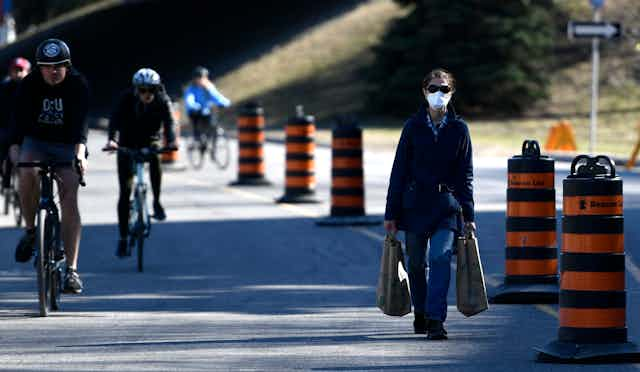As Canadian cities recover and rebuild their economies post-pandemic, there will be increasing need to deliver social and community planning measures to address widening income inequalities.
As well, as joblessness worsens, the ordinary lives and well-being of Canadians will undoubtedly suffer further harm. Much of this pain will be felt in neighbourhoods where many are struggling from the impact of isolation.
As bleak as this forecast may sound, we must look for hope and leverage community resiliency to rebuild our cities and neighbourhoods. To do this well, we will need to harness the right set of tools for what can only be described as a generational undertaking in social and community development.
Can we look for hope in times of despair?
Over the past 30 years, income inequality in Canada has deepened and is being felt most acutely in our neighbourhoods, where economic and social change have been dramatic. Using measures like income inequality allows us to describe the distribution of wealth within a country or city.
Ideally, having wealth more evenly distributed among the population can help address the economic gap between the wealthiest Canadians and the poorest. But in Canada, the highest earning households have increased their wealth dramatically while middle- and low-income earners have fallen further behind.
For the better part of a decade, I have been part of a group of academics from across Canada working to understand how these complex changes have affected neighbourhoods. Most recently, the aptly titled “Changing Canadian Neighbourhoods” examined economic and social trends over the past 40 years.
This work has revealed that income distribution has shifted, with the wealthiest one per cent ending up with a bigger share of the economic pie. On the ground, this has altered the social-spatial structure of cities, meaning urban centres are now more spatially divided, with rich and poor neighbourhoods becoming more visible and all too common.

Another way we have explained this is by applying the term income polarization. For cities, this polarizing effect is resulting in class separation with clusters or concentrations of poorer neighbourhoods at one end and rich enclaves at the other.
While the incomes of the rich and poor have grown further apart, there has been an almost silent disappearance of the middle-income Canadian. Perhaps this is why neighbourhoods tend to be clustering at the higher or lower end of the income spectrum.
The disappearing middle-income household
The loss of the middle-income neighbourhood has hurt our cities and our economies. It’s evident today as many Canadians financially succumb quickly to the economic downturn. The eroding middle class has also pushed many more into the ranks of the working poor, where livelihoods are being measured between paycheques and via temporary jobs that have replaced the economic stability that was the hallmark of the baby boomer generation.
Boomers were much more likely to have longer-term employment and perhaps even a pension. Both now seem like a pipe dream for most.
Presently, there is a collective sense of profound anguish for the current health crisis. First and foremost, our attention must remain on the front lines, with a resolve to continue to support measures aimed at slowing the spread of COVID-19 and treating those hardest hit.

Cities have fought equally tough pandemics and plagues for generations. In each of these historic periods, amid the grief and despair, there emerged a resolution to never again tolerate conditions that fuelled those pandemics.
Read more: How the rich reacted to the bubonic plague has eerie similarities to today's pandemic
Over the past 100 years, cities and communities responded by enacting tougher health measures to improve livability of cities, to design better and safer buildings and to address root causes, including how poor living conditions and poverty played a mitigating role.
As we move into the summer and perhaps into the fall and coming winter, we will need to roll up our sleeves with the same fervour that helped us take on the influenza epidemic 100 years ago and countless outbreaks of cholera. We’ll truly beat COVID-19 by coming out stronger and more resilient.
Focus on rebuilding communities
Today, we can worry less about building standards and sewage treatment to focus more on helping citizens rebuild their communities and social infrastructure. This will require us to get back to the basics of community and social planning so that we can help empower local community organizations to begin the long road back to community recovery.
Read more: Canada’s co-operatives: Helping communities during and after the coronavirus
We focused previously on bricks-and-mortar approaches to stimulate the economy, but coming out of this pandemic, we’ll need to be mindful of addressing the mental health of citizens as much as the economy.
In our neighbourhoods, community-based organizations must have the support of government to deliver grassroots solutions that fuel positive changes. The city of Winnipeg is a good example of how community-based solutions are addressing decades of deep poverty and stagnant growth.

In Winnipeg’s inner city, organizations like West Broadway have spent more than 25 years working on social and community initiatives that bring residents together on such projects as growing and sharing food, offering small grants for local beautification projects, promoting well-being and community resilience.
At the heart of this type of social and community planning are the community members whose lives have been impacted and who will need a range of post-pandemic supports.
For Canada to shift into recovery mode, we must take a more holistic view of how to rebuild economies and cities. The work of organizations like the Neighbourhood Change project envisions that this rebuilding will begin with strong communities empowered by the local capacity to build resiliency and hope — one person at a time.

